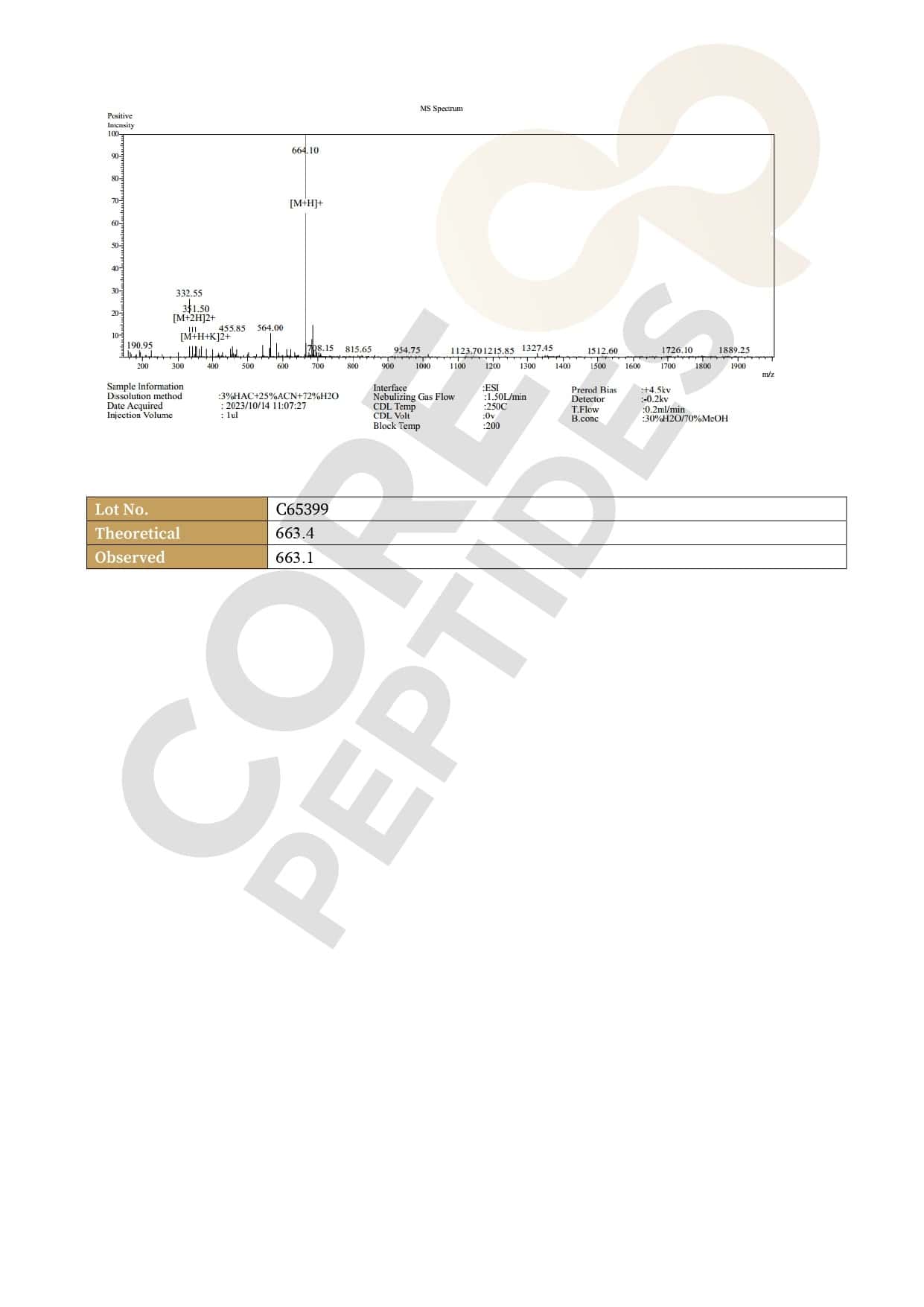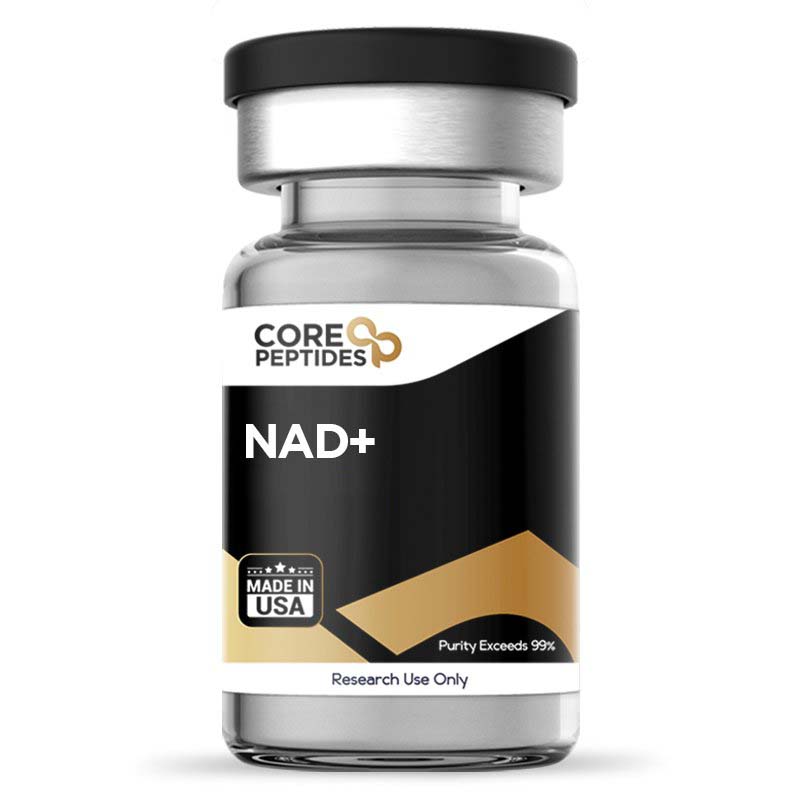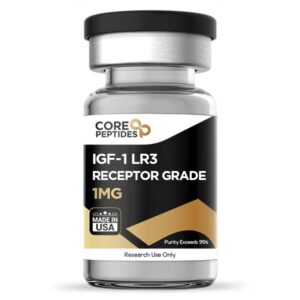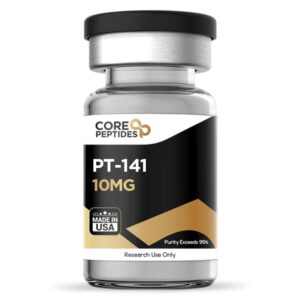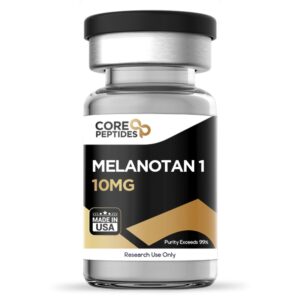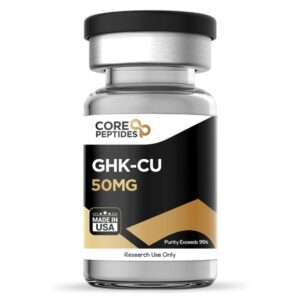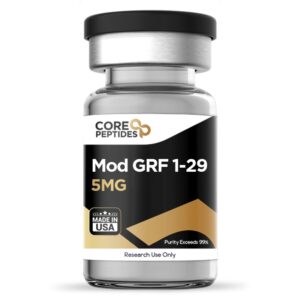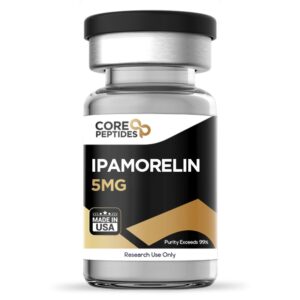NAD+ (100mg / 750mg)
$44.00 – $273.00
Size: 100mg / 750mg
Contents: NAD+
Form: Lyophilized powder
Purity: >99%
SKU: P-NADPLUS-100-750
FREE Shipping on $100+ orders
FREE Bacteriostatic Water (30ml) on $200+ orders
Discount per Quantity
| Quantity | Discount | Price |
|---|---|---|
| 5 - 8 | 5% | $41.80 – $259.35 |
| 9 + | 10% | $39.60 – $245.70 |
NAD+ Peptide
NAD+ is an acronym for Nicotinamide Adenine Dinucleotide, an endogenous nucleotide that is considered to regulate primary functions such as metabolism, energy production, and DNA repair. It is also considered to act as a secondary messenger via calcium-dependent signaling mechanisms, possibly serving as an immunoregulatory component.(1,2) NAD+ is considered by researchers to be naturally synthesized via the de novo mechanism of converting the amino acid tryptophan through several enzymatic steps. Researchers posit that there are five components to NAD+ synthesis, including tryptophan, nicotinamide, nicotinic acid, nicotinamide riboside, and nicotinamide mononucleotide.(3) Once synthesized, research suggests it exerts over 500 enzymatic reactions and cellular processes(12) to aid metabolic activities. Essentially, it is suggested to act as a coenzyme in redox functions, converted to NADH (the energy-carrying form of NAD+), which may involve other metabolic pathways.
Overview
Researchers have suggested Nicotinamide Adenine Dinucleotide (NAD+) to act as a coenzyme, with three major classes of enzymes including:
- Deacetylase enzymes in the sirtuin class (SIRTs)
- Poly ADP ribose polymerase (PARPs) enzymes, and
- Cyclic ADP ribose synthetase (cADPRS)
Research suggests that each class of enzymes interacts with NAD+ in the following possible respects:
- SIRTs may stimulate mitochondrial homeostasis, stem cell regeneration, loss of stem cells, and nerve degeneration.
- PARPs, composed of 17 different enzymes, may act alongside NAD+ enzymes and synthesize poly ADP ribose polymers, which may lead to genome stability.
- cADPRS include CD38 and CD157, which are considered to be key immunological cells. cADPRS appears to hydrolyze NAD+ and thereby may stimulate stem cell regeneration and DNA repair, which may be important for maintaining cell cycles.
Researchers suggest the above-mentioned enzymes to be NAD+ dependent enzymes, possibly acting based on the presence of Nicotinamide Adenine Dinucleotide (NAD). Researchers suggest that should all three enzymes be dependent on NAD+, they may potentially compete amongst themselves for bioavailability. It has been posited that the potential function of SIRTs, for instance, may lead to reduced PARPs activity and, thereby, potentially lead to weakened systems. Hence, it may be critical to maintain a balance between the availability and consumption of NAD+ to obtain optimal potential impact.(5)
Chemical Makeup
Molecular Formula: C21H27N7O14P2
Molecular Weight: 663.43 g/mol
Other known titles: nicotinamide adenine dinucleotide
Research and Clinical Studies
NAD+ Peptide and Productive Aging
Researchers suggest that NAD+ has two key intermediates: nicotinamide riboside (NR) and nicotinamide mononucleotide (NMN). Studies have indicated that these intermediates may be potent agents for promoting 'productive aging.' In a study,(7) normal-aging mice were exposed to the NMN intermediate for 12 months. Following the study, the researchers suggested that NMN may promote NAD+ synthesis in the mice. Peptide exposure may have been the catalyst for the observed reduced weight gain, increased energy metabolism, enhanced physical activity, improved lipid profile, and other physiological impacts in the mice.
NAD+ Peptide and Neurodegenerative Activity
Scientists consider mitochondrial dysfunction to lead to various functional limitations in the electron transport chain and ATP (energy) synthesis, possibly resulting in various neurodegenerative diseases. A study(8) was conducted where aged mice were exposed to NMN, a NAD+ intermediate, for 3 to 12 months. The study's main aim was to evaluate the potential impact of the peptide on mitochondrial respiratory processes, for which fluorescent NMN protein was presented to the mice models. After peptide introduction, the mitochondrial oxygen consumption rates in the nerve and brain cells of the mice were studied. Upon analysis, it was suggested that mitochondrial functions had been restored in the aged mice, suggesting that NMN may be immediately utilized by the cells to produce NAD+, exerting a possible positive impact.
NAD+ Peptide and DNA Repair After Ischemic Stress
The main aim of this study(11) was to determine the neuroprotective potential of Nicotinamide Adenine Dinucleotide against ischemic stress induced in mice. For this study, ischemic stress was induced in the neuronal cultures in rats via deprivation of oxygen and glucose for about 2 hours. NAD+ was directly replenished into the culture medium before or after the induced ischemic stress. After 72 hours of introducing NAD+ into the cultures, it was reported by the researchers that the DNA base excision repair activity (DNA BER), cell viability, and oxidative DNA damage repair appeared to be significantly improved, irrespective of whether Nicotinamide Adenine Dinucleotide was added before or after inducing the ischemic stress.
Indeed, NAD+ appears crucial for DNA integrity, with studies focusing on the enzyme poly(ADP-ribose) polymerase (PAR polymerase or PARP), which might depend on NAD+ for activating DNA repair. In the event of DNA damage, it is thought that PARP might be triggered, potentially attaching itself to the DNA's damaged parts. Researchers suggest that PARP might utilize NAD+ molecules to add ADP-ribose units to itself and other proteins in a process known as PARylation, potentially aiding in the attraction and activation of other DNA repair proteins and thereby assisting in repairing DNA damage.(15) This PARylation may lead to the formation of PAR chains, which might signal the DNA repair systems to identify and address DNA damage. PARP is also considered to have a role in detecting and mending single-strand DNA breaks. If NAD+ is confirmed as a necessary cofactor, PARP may be important in preserving genomic stability by initiating DNA repair mechanisms. However, this activity could also reduce NAD+ levels within cells, potentially affecting other NAD+-dependent processes like energy production and cellular signaling. It has been noted that DNA damage may cause a rapid increase in PAR synthesis, possibly using up significant amounts of NAD+. Consequently, researchers are exploring the idea that NAD+ depletion, triggered by PAR polymerase activation, might influence the NAD+/SIRT1 pathway, potentially affecting mitochondrial function, ROS production, DNA repair, and cell survival.(16) Consequently, the reintroduction of NAD+ in such settings may compensate for this and may be posited to support the process of DNA repair and cell survival.
NAD+ Peptide and the Liver, Kidney
Upon introducing experimental mice with the NAD+ peptide and stimulating an increase in Nicotinamide Adenine Dinucleotide levels up to normal concentrations, researchers suggested the peptide exhibited positive potential in preventing obesity and alcoholic hepatitis while possibly improving glucose homeostasis and overall liver function. When aged mice kidney cells were supplemented with NAD+, the results indicated that adding the peptide possibly promoted SIRTs activity, which exhibited neuroprotective potential against glucose-induced kidney cell hypertrophy. Furthermore, when presented with NMN, NAD+ intermediate, it appeared to promote neuroprotective impact against cisplatin-induced kidney injury.(12)
NAD+ Peptide and Skeletal Function
Upon presenting aged mice with NMN daily for 7 days, researchers suggested that the peptide possibly increased ATP production, reduced inflammation, and elevated mitochondrial functions.(13) The researchers considered this may have been due to the role that NAD+ appears to play in cellular respiration and energy production, specifically acting as a helper molecule in redox reactions, which may be vital to converting nutrients into energy. This process, known as cellular respiration, is thought to allow cells to produce usable energy through a series of steps, and NAD+ is believed to play a key role in two specific phases: glycolysis and the citric acid cycle (or Krebs cycle). In glycolysis, the initial breakdown of glucose into pyruvate is suggested to be produced by a small amount of ATP and NADH. Here, NAD+ is thought to accept electrons and a hydrogen ion from glucose, turning into NADH. This transformation might allow NADH to transport these high-energy electrons to a later stage of energy production. Following glycolysis, pyruvate is further broken down in the citric acid cycle, potentially releasing more energy. NAD+ is implicated in various reactions during this cycle, possibly accepting electrons and hydrogen ions to form NADH. These crucial steps are considered to happen directly within the mitochondria. The NADH formed during both glycolysis and the citric acid cycle is presumed to carry high-energy electrons to the electron transport chain, the last step of cellular respiration. At this stage, NADH may give up its electrons, creating an electrochemical gradient and a chain reaction that drives protons across the mitochondrial membrane. This action appears to lead to the combination of electrons and protons with oxygen to produce water, and the energy released during this process may be used to generate ATP through oxidative phosphorylation. As NADH relinquishes its electrons, it may be transformed back into NAD+, ready to assist in another glycolysis and citric acid cycle. This regeneration of NAD+ is considered to be crucial for the ongoing production of ATP, thus maintaining the cell's energy supply.
NAD+ Peptide and Cardiac Functions
Researchers have suggested Nicotinamide Adenine Dinucleotide deficiency may lead to reduced SIRT activity, which may in turn cause reduced energy production and aortic constriction. When mice were exposed to NMN 30 minutes prior to induced-ischemia, the peptide reportedly produced a cardioprotective function against ischemic injury.(14)
NAD+ peptide is available for research and laboratory purposes only. Please review and adhere to our Terms and Conditions before ordering.
References:
- Schultz, Michael B, and David A Sinclair. "Why NAD(+) Declines during Aging: It's Destroyed." Cell metabolism vol. 23,6 (2016): 965-966. https://www.ncbi.nlm.nih.gov/pmc/articles/PMC5088772/
- Braidy N, Liu Y. NAD+ therapy in age-related degenerative disorders: A benefit/risk analysis. Exp Gerontol. 2020 Apr;132:110831. doi: 10.1016/j.exger.2020.110831. https://pubmed.ncbi.nlm.nih.gov/31917996/
- Johnson, Sean, and Shin-Ichiro Imai. "NAD + biosynthesis, aging, and disease." F1000Research vol. 7 132. 1 Feb 2018. https://www.ncbi.nlm.nih.gov/pmc/articles/PMC5795269/
- Bieganowski P, Brenner C. Discoveries of nicotinamide riboside as a nutrient and conserved NRK genes establish a Preiss-Handler independent route to NAD+ in fungi and humans. Cell. 2004 May 14;117(4):495-502. https://pubmed.ncbi.nlm.nih.gov/15137942/
- Fang, E. F., Lautrup, S., Hou, Y., Demarest, T. G., Croteau, D. L., Mattson, M. P., & Bohr, V. A. (2017). NAD+ in Aging: Molecular Mechanisms and Translational Implications. Trends in molecular medicine, 23(10), 899–916. https://www.ncbi.nlm.nih.gov/pmc/articles/PMC7494058/
- Harden, A; Young, WJ (24 October 1906). "The alcoholic ferment of yeast-juice Part II.--The coferment of yeast-juice". Proceedings of the Royal Society of London. Series B, Containing Papers of a Biological Character. 78 (526): 369–375. https://royalsocietypublishing.org/doi/10.1098/rspb.1906.0070
- Mills KF, Yoshida S, Stein LR, Grozio A, Kubota S, Sasaki Y, Redpath P, Migaud ME, Apte RS, Uchida K, Yoshino J, Imai SI. Long-Term Administration of Nicotinamide Mononucleotide Mitigates Age-Associated Physiological Decline in Mice. Cell Metab. 2016 Dec 13;24(6):795-806. https://pubmed.ncbi.nlm.nih.gov/28068222/
- Long AN, Owens K, Schlappal AE, Kristian T, Fishman PS, Schuh RA. Effect of nicotinamide mononucleotide on brain mitochondrial respiratory deficits in an Alzheimer's disease-relevant murine model. BMC Neurol. 2015 Mar 1;15:19. https://pubmed.ncbi.nlm.nih.gov/25884176/
- Safety & Efficacy of Nicotinamide Riboside Supplementation for Improving Physiological Function in Middle-Aged and Older Adults. https://clinicaltrials.gov/ct2/show/NCT02921659
- Braidy N, Liu Y. NAD+ therapy in age-related degenerative disorders: A benefit/risk analysis. Exp Gerontol. 2020 Apr;132:110831. https://pubmed.ncbi.nlm.nih.gov/31917996/
- Wang S, Xing Z, Vosler PS, Yin H, Li W, Zhang F, Signore AP, Stetler RA, Gao Y, Chen J. Cellular NAD replenishment confers marked neuroprotection against ischemic cell death: role of enhanced DNA repair. Stroke. 2008 Sep;39(9):2587-95. https://pubmed.ncbi.nlm.nih.gov/18617666/
- Rajman, Luis et al. "Therapeutic Potential of NAD-Boosting Molecules: The In Vivo Evidence." Cell metabolism vol. 27,3 (2018): 529-547. https://www.ncbi.nlm.nih.gov/pmc/articles/PMC6342515/
- Heer C, et al, Coronavirus infection and PARP expression dysregulate the NAD metabolome: An actionable component of innate immunity. Journal of Biological Chemistry. Volume 295, Issue 52, Dec 2020. https://www.jbc.org/article/S0021-9258(17)50676-6/fulltext
- Mehmel, Mario et al. "Nicotinamide Riboside-The Current State of Research and Therapeutic Uses." Nutrients vol. 12,6 1616. 31 May. 2020, doi:10.3390/nu12061616 https://www.ncbi.nlm.nih.gov/pmc/articles/PMC7352172/
- Leung A, Todorova T, Ando Y, Chang P. Poly(ADP-ribose) regulates post-transcriptional gene regulation in the cytoplasm. RNA Biol. 2012 May;9(5):542-8. doi: 10.4161/rna.19899. Epub 2012 May 1. PMID: 22531498; PMCID: PMC3495734.
- Croteau DL, Fang EF, Nilsen H, Bohr VA. NAD+ in DNA repair and mitochondrial maintenance. Cell Cycle. 2017 Mar 19;16(6):491-492. doi: 10.1080/15384101.2017.1285631. Epub 2017 Feb 1. PMID: 28145802; PMCID: PMC5384578.
Certificate of Analysis (100mg)
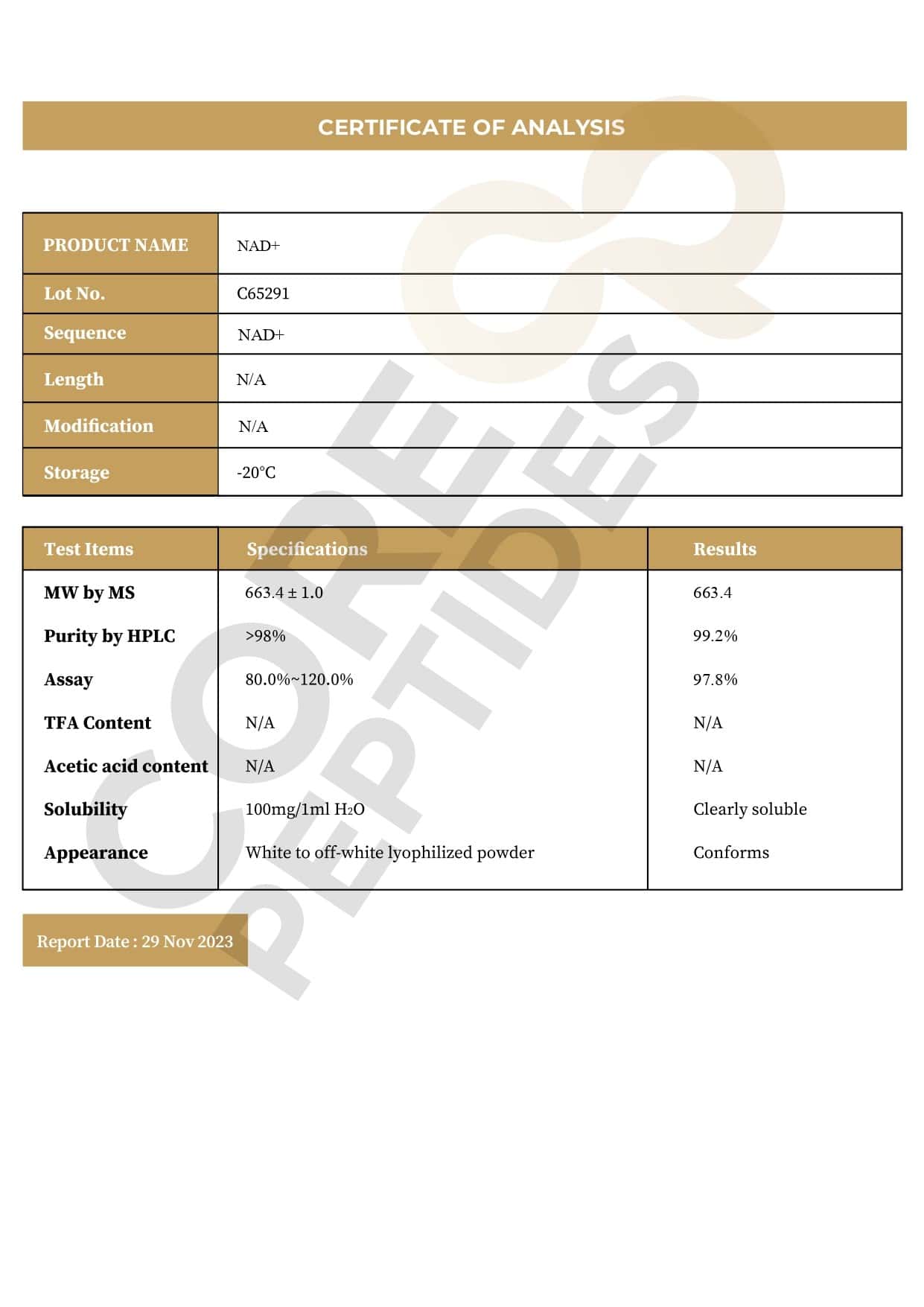
Certificate of Analysis (750mg)
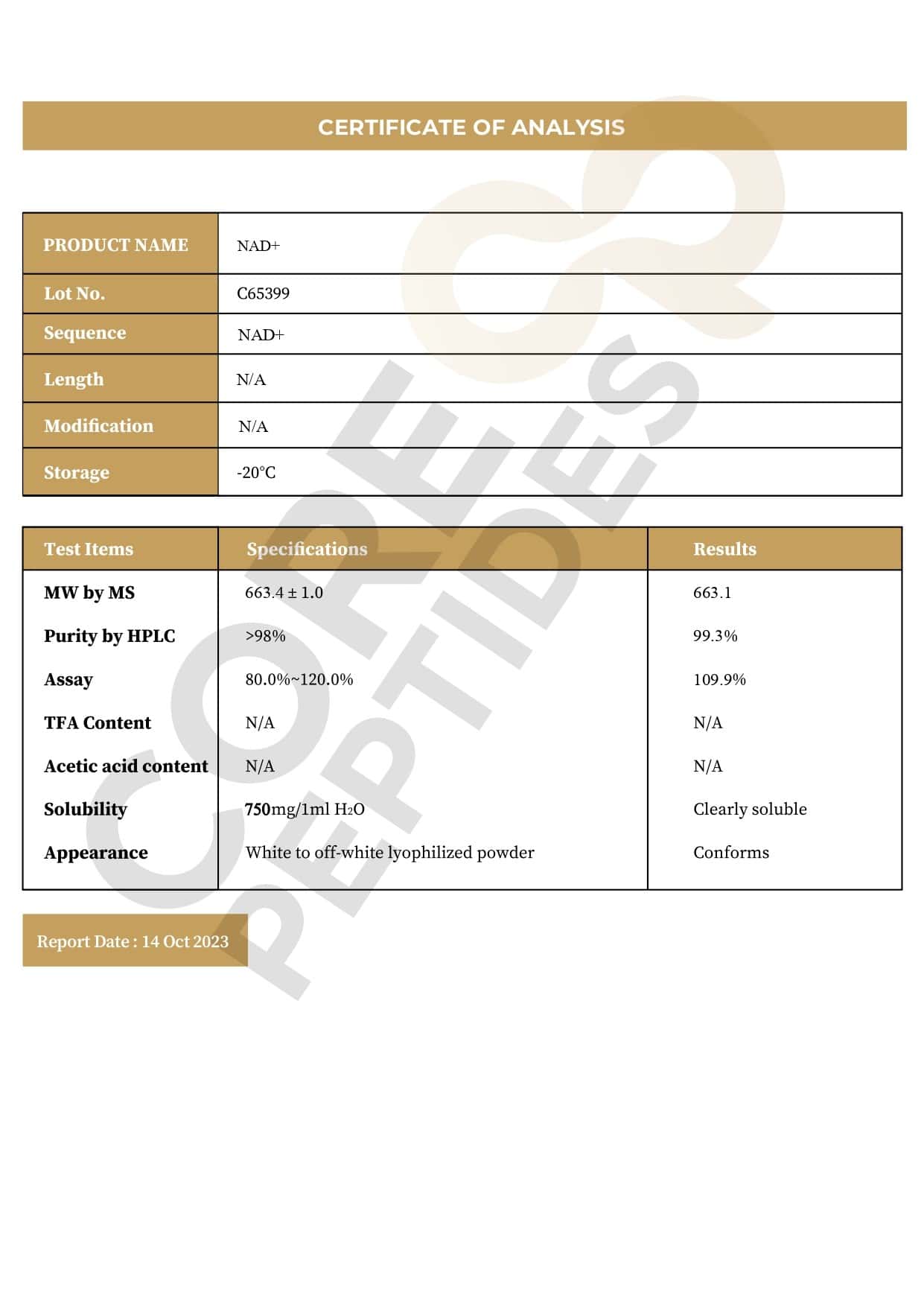
High Performance Liquid Chromatography (100mg)
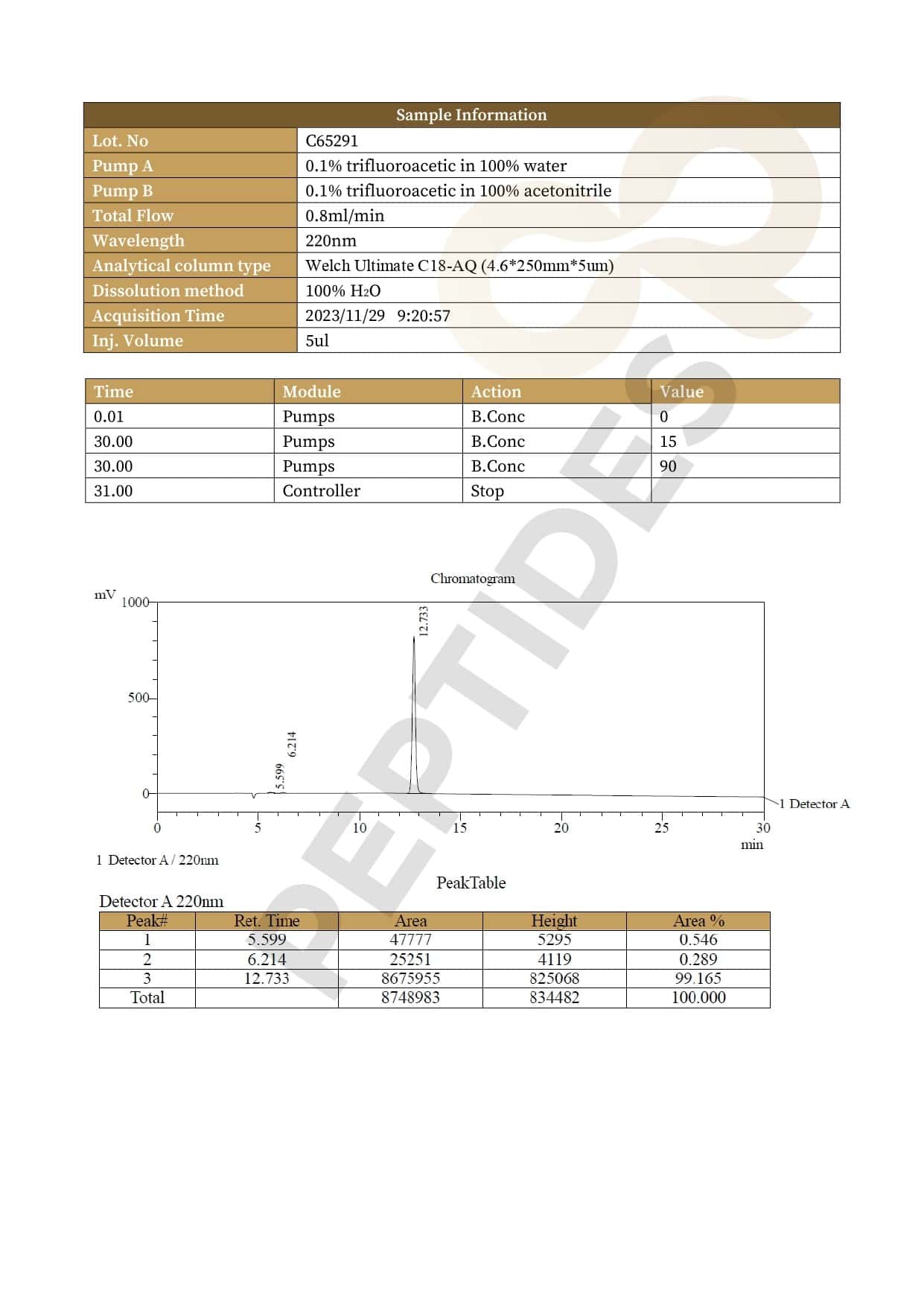
High Performance Liquid Chromatography (750mg)
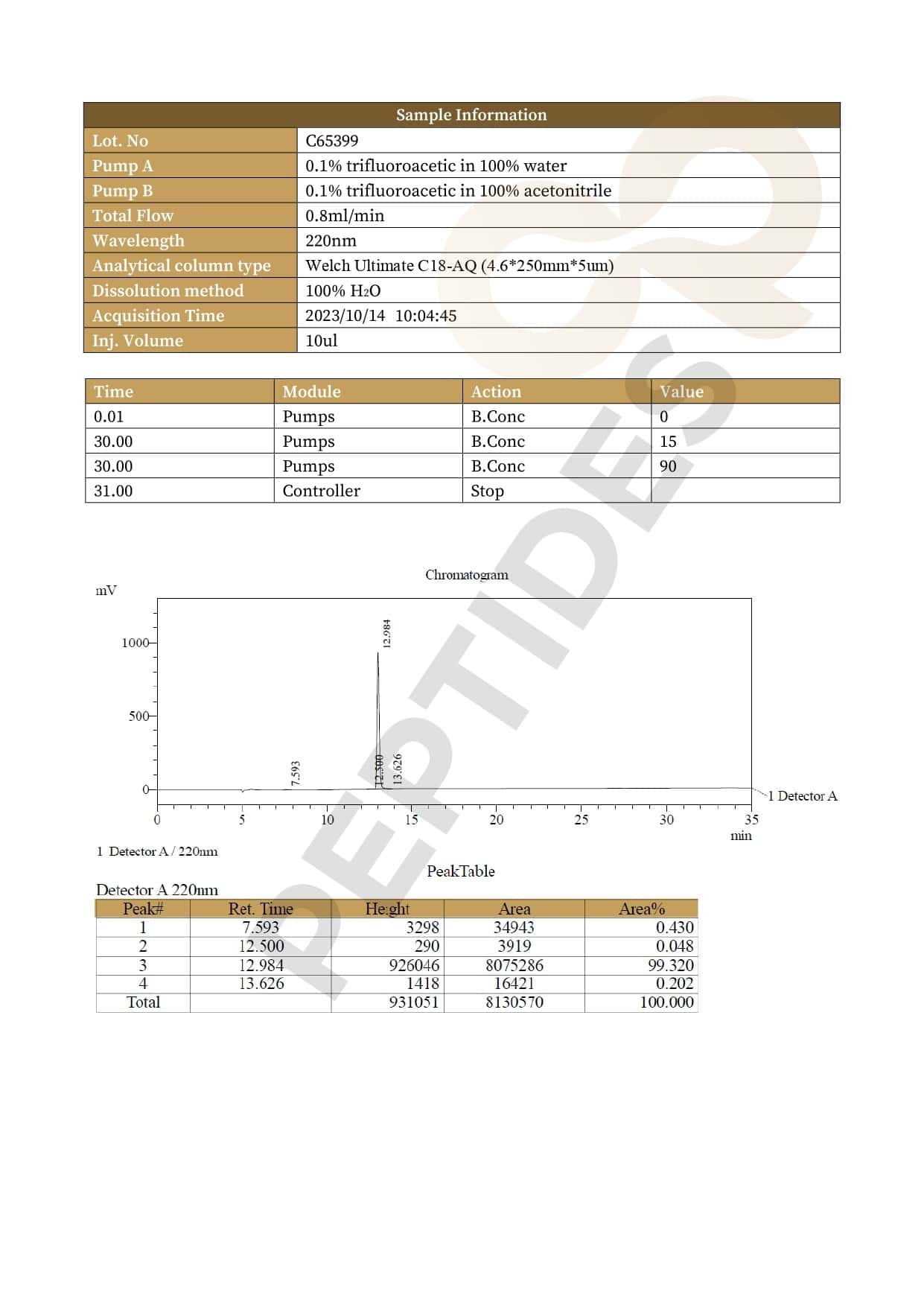
Mass Spectrometry (100mg)
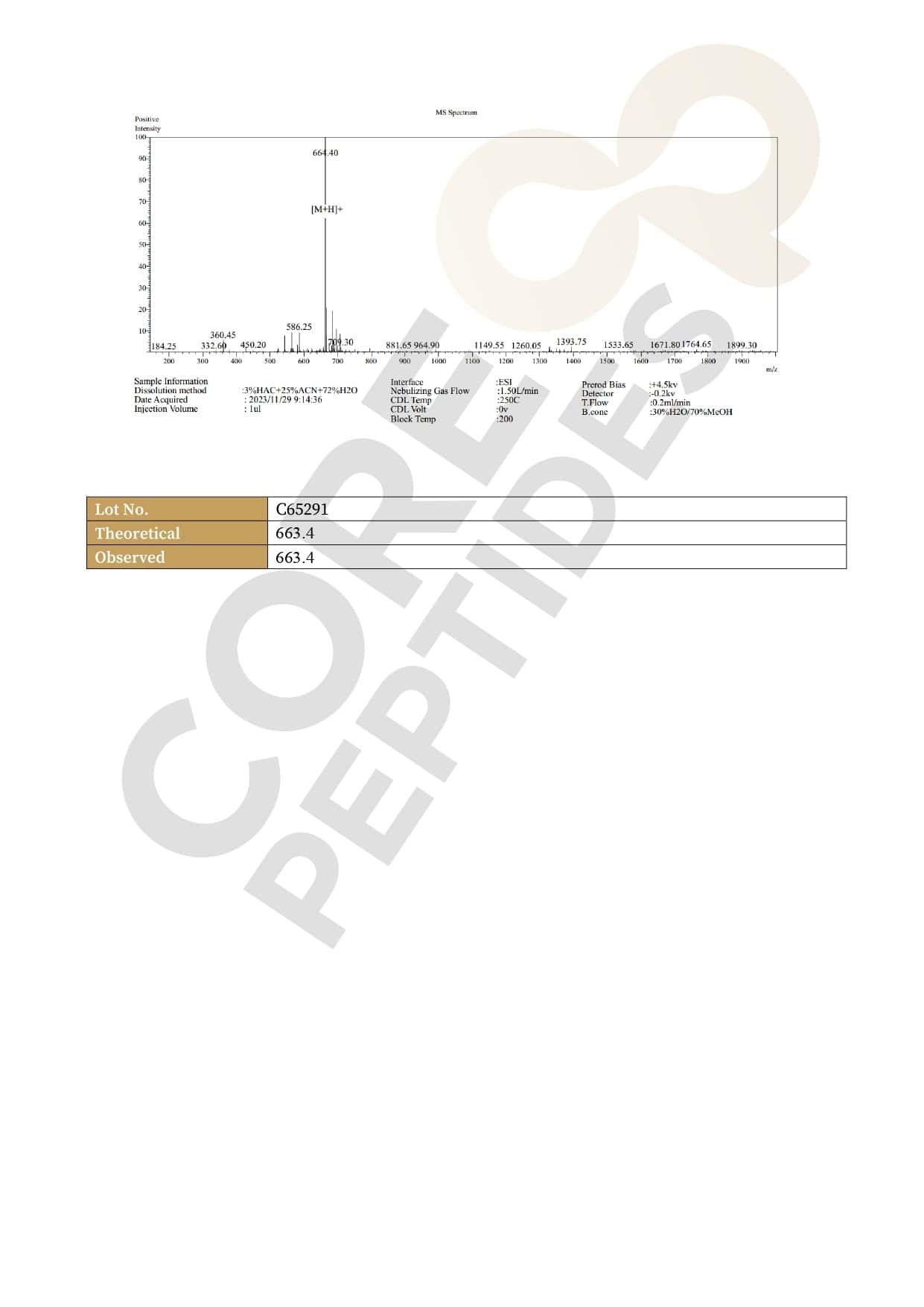
Mass Spectrometry (750mg)
